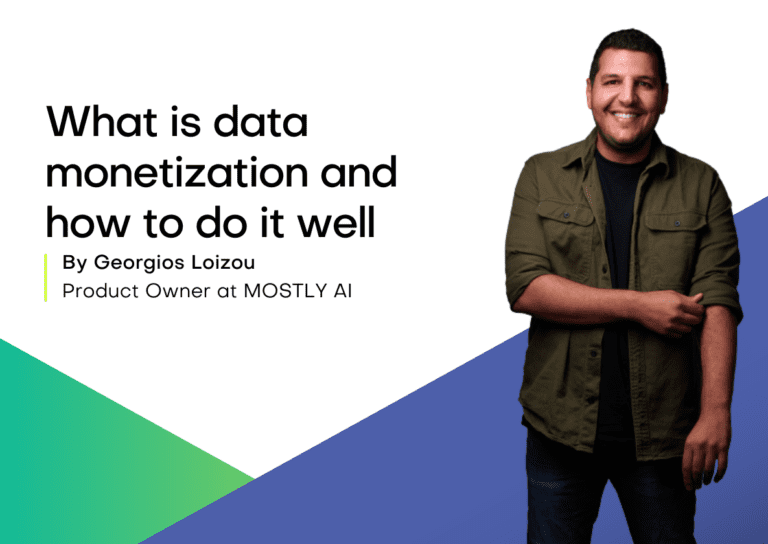Historically, synthetic data has been predominantly used to anonymize data and protect user privacy. This approach has been particularly valuable for organizations that handle vast amounts of sensitive data, such as financial institutions, telecommunications companies, healthcare providers, and government agencies. Synthetic data offers a solution to privacy concerns by generating artificial data points that maintain the same patterns and relationships as the original data but do not contain any personally identifiable information (PII).
There are several reasons why synthetic data is an effective tool for privacy use cases:
- Privacy by design: Synthetic data is generated in a way that ensures privacy is built into the process from the beginning. By creating data that closely resembles real-world data but without any PII, synthetic data allows organizations to share information without the risk of exposing sensitive information or violating privacy regulations.
- Compliance with data protection regulations: Synthetic data helps organizations adhere to data protection laws, such as the General Data Protection Regulation (GDPR) and the Health Insurance Portability and Accountability Act (HIPAA). Since synthetic data does not contain PII, organizations can share and analyze data without compromising user privacy or breaching regulations.
- Collaboration and data sharing: Synthetic data enables organizations to collaborate and share data more easily and securely. By using synthetic data, researchers and analysts can work together on projects without exposing sensitive information or violating privacy rules.
However, recent advancements in technology and machine learning have illuminated the vast potential of synthetic data, extending far beyond the privacy use case. A recent paper from Boris van Breugel and Michaela van der Schaar describes how AI-generated synthetic data moved beyond the data privacy use case. In this blog post, we will explore the potential of synthetic data beyond data privacy applications and the direction in which MOSTLY AI's synthetic data platform has been developing, including new features beyond privacy, such as data augmentation and data balancing, domain adaptation, simulations, and bias and fairness.
Data augmentation and data balancing
Synthetic data can be used to augment existing datasets, particularly when there is just not enough data or there is an imbalance in data representation. Already back in 2020 we showed that by simply generating more synthetic data than was there in the first place, it’s possible to improve the performance of a downstream task.
Since then, we have seen more and more interest in utilizing synthetic data to boost the performance of machine learning models. And there are two distinct approaches that one can take to achieve this: either amplifying existing data by creating more synthetic data (as we did in our research) and only working with the synthetic data or mixing real and synthetic data.
But synthetic data can also help with highly imbalanced datasets. In the realm of machine learning, imbalanced datasets can lead to biased models that perform poorly on underrepresented data points. Synthetic data generation can create additional data points for underrepresented categories, effectively balancing the dataset and improving the performance of the resulting models. We recently published a blog post on data augmentation with details about how our platform can be used to augment existing datasets.

Domain adaptation
In many cases, machine learning models are trained on data from one domain but need to be applied to a different domain where no or not enough training data exists, or where it would be costly to obtain that data. Synthetic data can bridge this gap by simulating the target domain's data, allowing models to adapt and perform better in the new environment. One of the advantages of this approach is that the standard downstream models don’t need to be changed and can be compared easily.
This has applications in various industries. We currently see the most applications of this use case in the unstructured data space. For example, when generating training material for autonomous vehicles, where synthetic data can be generated to simulate different driving conditions and scenarios. Or, similarly, in medical imaging, synthetic data can be generated to mimic different patient populations or medical conditions, allowing healthcare professionals to test and validate machine learning algorithms without the need for vast amounts of real-world data, which can be challenging and expensive to obtain.
However, the same approach and benefits hold true for structured, tabular data as well and it’s an area where we see great potential for structured synthetic data in the future.
Data simulations
But what happens if there is no real-world data at all to work with? Synthetic data can help in this scenario too. Synthetic data can be used to create realistic simulations for various purposes, such as testing, training, and decision-making. Companies can develop synthetic business scenarios and simulate customer behavior.
One example is the development of new marketing strategies for product launches. Companies can generate synthetic customer profiles that represent a diverse range of demographics, preferences, and purchasing habits. By simulating the behavior of these synthetic customers in response to different marketing campaigns, businesses can gain insights into the potential effectiveness of various strategies and make data-driven decisions to optimize their campaigns. This approach allows companies to test and refine their marketing efforts without the need for expensive and time-consuming real-world data collection.
In essence simulated synthetic data holds the potential of being the realistic data that every organization wishes to have: data that is relatively low-effort to create, cost-efficient, and highly customizable. This flexibility will allow organizations to innovate, adapt, and improve their products and services more effectively and efficiently.
Bias and fairness
Bias in datasets can lead to unfair and discriminatory outcomes in machine learning models. These biases often stem from historical data that reflects societal inequalities and prejudices, which can inadvertently be learned and perpetuated by the algorithms. For example, a facial recognition system trained on a dataset predominantly consisting of light-skinned individuals may have difficulty accurately identifying people with darker skin tones, leading to misclassifications and perpetuating racial bias. Similarly, a hiring algorithm trained on a dataset with a higher proportion of male applicants may inadvertently favor male candidates over equally qualified female candidates, perpetuating gender discrimination in the workplace.
Therefore, addressing bias in datasets is crucial for developing equitable and fair machine learning systems that provide equal opportunities and benefits for all individuals, regardless of their background or characteristics.
Synthetic data can help address these issues by generating data that better represents diverse populations, leading to more equitable and fair models. In short: one can generate fair synthetic data based on unfair real data. Already 3 years ago we showed this in our 5-part Fairness Blogpost Series that you can re-read to learn why bias in AI is a problem and how bias correction is one of the main potentials of synthetic data. There we also show the complexity and challenges of the topic including first and foremost how to define what is fair. We see an increasing interest in the market for leveraging synthetic data to address biases and fairness.
There is no question about it: the potential of synthetic data extends far beyond privacy and anonymization. As we showed, synthetic data offers a range of powerful applications that can transform industries, enhance decision-making, and ultimately change the way we work with data. By harnessing the power of synthetic data, we can unlock new possibilities, create more equitable models, and drive innovation in the data-driven world.



